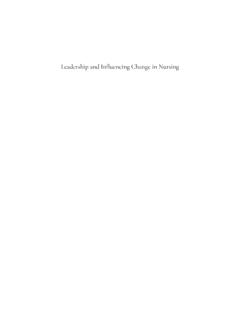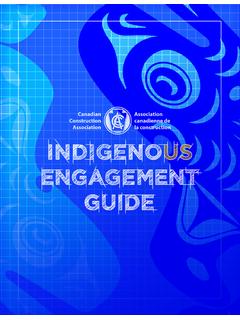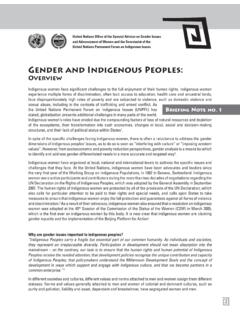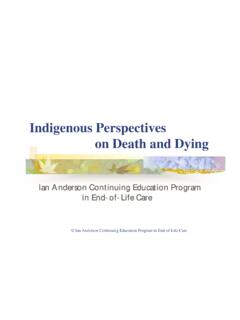Transcription of Chapter VII Indigenous peoples and ethnic minorities ...
1 97 Chapter VII Indigenous peoples and ethnic minorities : marginalization is the normIntroductionThere is no internationally agreed definition of what constitute Indigenous peoples or ethnic minorities . An ethnic group generally shares a common sense of identity and common characteristics such as language, religion, tribe, nationality, race or a combination thereof. The term ethnic minority generally refers to ethnic or racial groups in a given country in which they are in a non-dominant position vis- -vis the dominant ethnic In this report, the term refers to a group of people in a nation State that meets one or more of the following criteria: it is numerically smaller than the rest of the population; it is not in a dominant position; it has a culture, lan-guage, religion or race that is distinct from that of the majority; and its members have a will to preserve those characteristics (Foa, 2015).
2 97 Some minorities are made up of the descendants of migrants or of groups brought to a country by force. In other cases, Indigenous peoples became minorities as a result of the settlement and colonization of their native territories by other peoples . Indigenous peoples possess distinct social, economic and political systems, lan-guages, cultures and beliefs and are determined to maintain and develop their iden-tity. Indigenous peoples can claim minority rights under international law, but specific 96 See also article 1 of the Declaration on the Rights of Persons Belonging to National or ethnic , Religious and Lin-guistic minorities (General Assembly resolution 47/135) and OHCHR (2010). 97 See United Nations (1979), para. messages Given that Indigenous persons and members of many ethnic minorities often work in informal employment, the reach of contributory schemes is limited.
3 Access to univer-sal, tax-financed social protection schemes needs to be extended in order to improve the well-being of members of both groups. Conditional cash transfers will not help to improve the well-being of beneficiaries or to close the ethnic gaps in health and education if services are of poor quality. Spatial segregation, discrimination and a lack of legal identification hamper access to social protection by Indigenous peoples and ethnic minorities . Intercultural dialogue and participation in decision-making by Indigenous peoples and ethnic minority communities on matters that affect them should serve as the foundation for the design and implementation of social protection programmes. Social protection alone cannot eliminate poverty and disadvantage among indige-nous peoples and ethnic minorities . Addressing the structural causes of disadvantage and promoting social inclusion requires a broader set of economic and social policies, including efforts to address discrimination.
4 98 Promoting Inclusion through Social Protectioninternational mandates and mechanisms also exist to protect the individual and col-lective rights of Indigenous peoples . Those distinctions have important political and practical is estimated that Indigenous peoples number from 300 million to 400 million worldwide (Gracey and King, 2009; Hall and Patrinos, 2012). Estimating the num-ber of people who belong to ethnic minorities is complex, partly because of differ-ences in definitions and methods of data collection. In China, for instance, census data indicated in 2010 that 113 million people identified with ethnic minorities (China, National Bureau of Statistics, 2011). In India, 104 million persons are identified as belonging to Scheduled Tribes and 201 million to Scheduled Castes, according to the 2011 In Latin America, census-based estimates put the number of persons of African descent at 130 million in 2015 (ECLAC, 2016a).
5 In the United States, more than a third of the population identified as Black, Asian, American Indian or Native American, Native Hawaiian or other Pacific Islander, or Hispanic of any race in 2016. The remainder identified as non-Hispanic Notwithstanding the diversity of Indigenous and ethnic minority groups around the world, they share common challenges. A shared history of exclusion and discrimi-nation based on identity has led to higher levels of poverty among them than in the dominant ethnic groups, as this Chapter shows. There are significant gaps in the social protection coverage of these groups and common explanations as to why. Although the situation of many Indigenous people and members of ethnic minorities has improved in recent years, some are still being left behind. A. Risks and disadvantages faced by Indigenous peoples and ethnic minoritiesIndigenous persons and members of many ethnic minorities , on average, are much more likely to live in poverty than the ethnic majority in any given country (Hall and Patrinos, 2012).
6 In Latin America, Indigenous peoples make up 8 per cent of the popula-tion but 14 per cent of those living in poverty (ECLAC, 2016a). According to one study, the percentage of Indigenous peoples living below the poverty line is higher than that of non- Indigenous groups in 14 out of 16 countries (Anderson and others, 2016).100 Moreover, members of those groups experience deeper poverty than the rest of the population. In China, for instance, ethnic minorities would require twice the amount of income as the majority just to reach the poverty line and thereby escape poverty; in Gabon, Indigenous peoples would require three times as much income, while in Viet Nam, it would take seven time as much income for ethnic minorities to escape poverty (Hall and Patrinos, 2012). In many cases, the rate of poverty reduction has been slower among those groups, and they suffer more often from chronic pov-erty poverty that is passed on from generation to generation (ibid.)
7 Disparities in poverty and income are in large part due to disadvantages experi-enced by Indigenous peoples and ethnic minorities in the labour market. That is espe- 98 For data see the Office of the Registrar General and Census Commissioner, Population Enumeration Data (Final Population). Available from (accessed 18 December 2017). The Indian census does not collect data on ethnicity but indicates whether a respondent belongs to a Scheduled Caste or Scheduled Tribe based on definitions contained in the Scheduled Castes and Scheduled Tribes Orders (Amendment) Act of 1976. 99 See United States Census Bureau for data. Available from (accessed 18 December 2017).100 The most significant differences were found in China (22 per cent higher among Tibetans), Thailand (31 per cent higher among non-Thai speakers), Panama (36 per cent higher among the Kuna Yala, Ember -Wounaan, and Ng be Bugl ), Peru (52 per cent higher among Indigenous Amazonians) and Venezuela (42 per cent higher among Indigenous peoples ).
8 99 Indigenous peoples and ethnic minorities : marginalization is the normcially true for Indigenous and ethnic minority women. In Latin America, for instance, the unemployment rate was per cent among women of African descent and per cent among white, non- Indigenous women in 2013 (ECLAC, 2016b). Among persons with similar levels of schooling, men who were not Indigenous or of African descent earned, on average, the highest wages, while Indigenous women and women of African descent earned significantly less than men and women who were not indig-enous or of African descent (ibid.). Indigenous persons in rural areas are more likely to work in the agricultural sector than their non- Indigenous counterparts, and informality is significantly higher among urban Indigenous than non- Indigenous workers (Patrinos and Skoufias, 2007).
9 After accounting for differences in age, education levels and place of residence, indig-enous persons and people of African descent are significantly less likely than white, non- Indigenous persons to work in high- or semi-skilled, non-manual occupations such as managers, professionals and office employees (United Nations, 2016a). Indigenous peoples and ethnic minorities are generally also worse off in terms of education and health than the ethnic majority. Young people from Indigenous and ethnic minority groups are less likely than their non- Indigenous and ethnic major-ity peers to complete lower-secondary school and go on to higher levels of schooling (United Nations, 2016a). In the most comprehensive global assessment of Indigenous health to date, life expectancy at birth for Indigenous peoples was more than five years lower than for the non- Indigenous population in Australia (Aboriginal and Torres Strait Islanders), Cameroon (Bakas), Canada (First Nations and Inuit), Kenya (Maasai), New Zealand (Maori) and Panama (Kuna Yala, Ember -Wounaan and Ng be Bugl ) (Anderson and others, 2016).
10 The higher likelihood of living in poverty is not the sole cause of worse health outcomes among Indigenous peoples . In private health facilities in Mexico in 2003, for example, Indigenous women received fewer prenatal procedures than non- Indigenous women, irrespective of their level of wealth (Barber, Bertozzi and Gertler, 2007). Simi-larly, members of ethnic minorities in the United States received lower quality health care, regardless of income or insurance status (Smedley, Stith and Nelson, eds., 2003).The legacy of colonization, slavery and dispossession of land, territories and resources is at the root of the disadvantage experienced by Indigenous peoples and many ethnic minorities . The remainder of this section focuses on three factors that drive the risks and disadvantages faced by Indigenous peoples and ethnic minorities : spatial disadvantage; culture and language; and prejudice and discrimination.
















